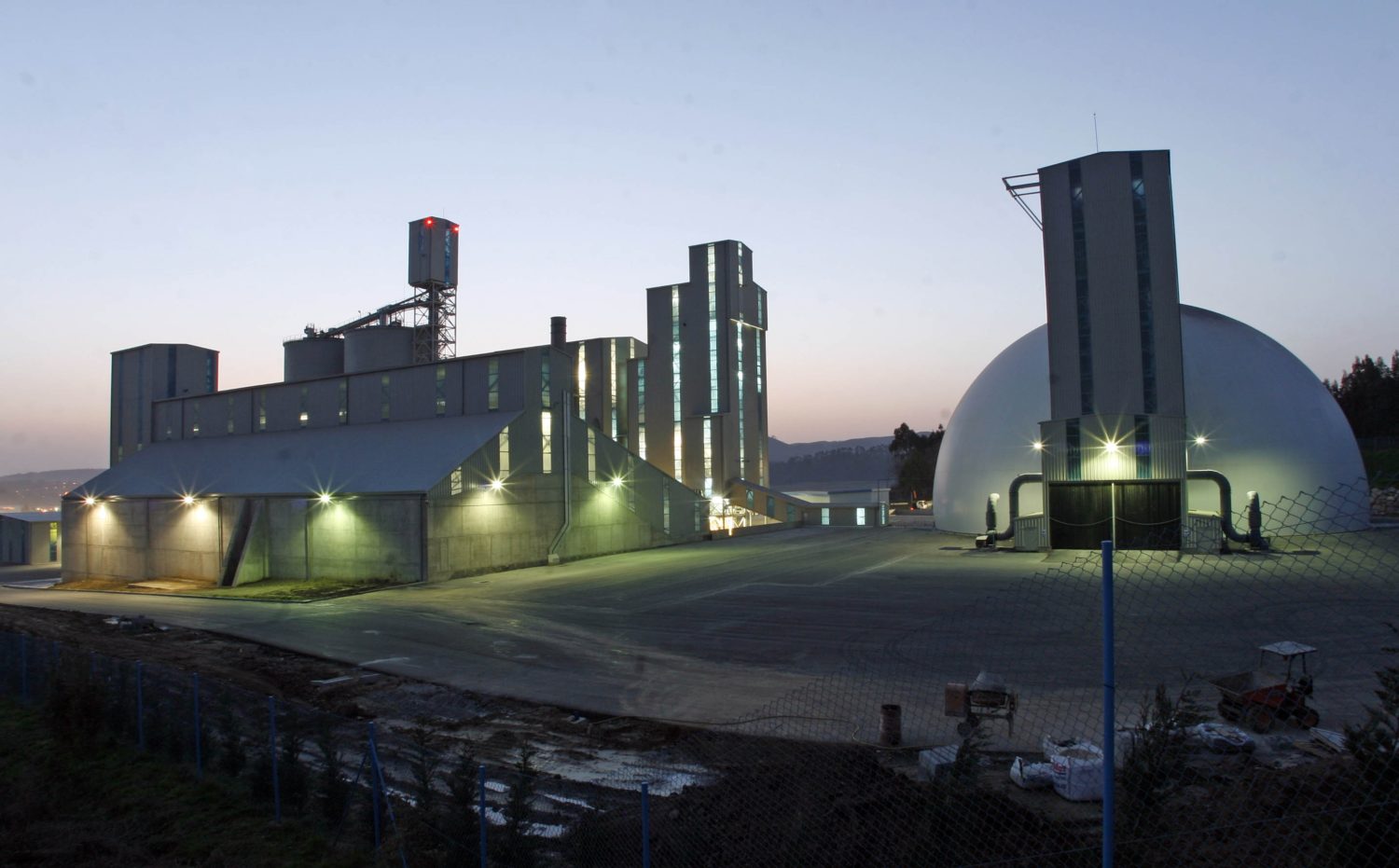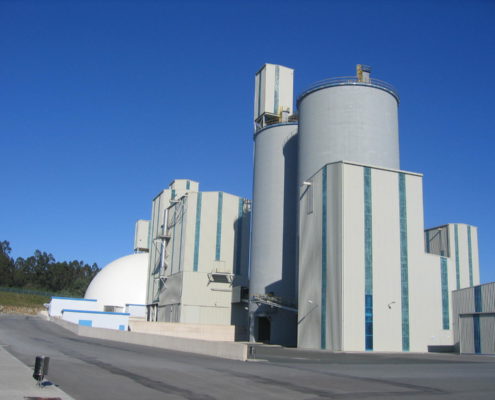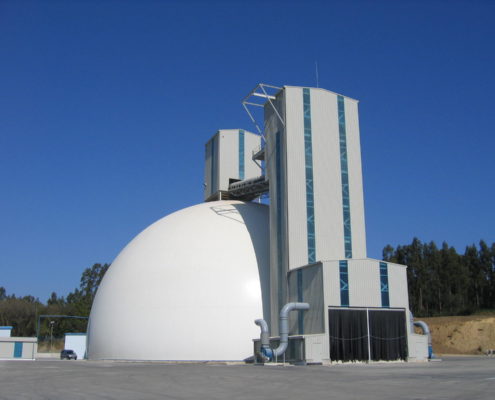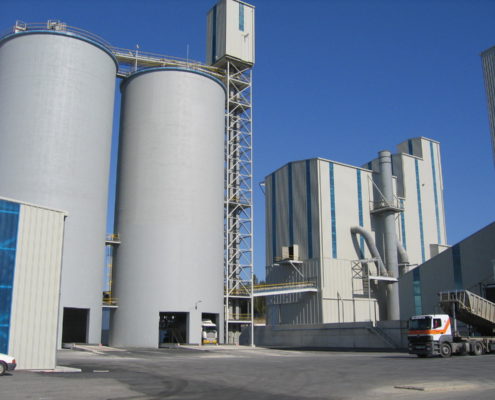This is a modern Milling, Storage and Cement Issuance Installation with the latest technical advances in the cement sector, providing lower energy consumption and an exemplary environmental behaviour.
It is located in the Municipal District of Narón, limiting with Ferrol, and built on a plot of around 64,500 m2.
Cementos Occidentales started to build this plant in October 2005 and it came into operation in January 2007. At the time, Cementos Occidentales created Cementos Gallegos to manage the Installation. SOCIEDAD ANÓNIMA TUDELA VEGUÍN, now Cementos Tudela Veguín S. A., acquired the Installation in July 2009.
Strategically located in the Río do Pozo Industrial Estate of this emerging and industrial Municipality, it has direct access both to the Internal Port of Ferrol, via the AP 9, and to the recently created External Port, via the N-655. In the same way, it is connected directly with the A 6 Motorway and with the A 8 Motorway of the Cantabrian via the AG 64.

All the activities carried out in the plant are under the scope of the Integrated Management System implemented according to ISO 9001, ISO 14001, ISO 45001 and ISO 50001 standards certified by an entity duly accredited for this purpose by ENAC. The Narón Cement Factory is also registered in the Galician Register of Centres Adhering to the Environmental Management and Audit System (EMAS as required by Decree 185/1999, of 17 June).
The Factory has Integrated Environmental Authorization 2017-IPPC-84-315 granted in 2018.
The commitment of the Management to the Integrated Policy of Quality, Environment and Occupational Health and Safety implies the management of the necessary means so that it is known, understood and implemented at all levels of the organization, as well as ensuring that all requirements are satisfied and the necessary means for continuous improvement are established.
The Plant can be divided into five (5) large areas or sections for its description:
The facility has Integrated Environmental Authorization 2017-IPPC-84-315 granted in 2018.
The commitment of the Management to the Integrated Policy of Quality, Environment and Occupational Health and Safety implies the management of the necessary means so that it is known, understood and implemented at all levels of the organization, as well as ensuring that all requirements are satisfied and the necessary means for continuous improvement are established.
STORAGE OF RAW MATERIALS
 All types of Cement always include Clinker and Gypsum as fixed components, the latter acting as the setting regulator. It also has other additions which, depending on the origin and percentage of such addition, lead to each of the cement types established in Standard UNE EN 197-1.
All types of Cement always include Clinker and Gypsum as fixed components, the latter acting as the setting regulator. It also has other additions which, depending on the origin and percentage of such addition, lead to each of the cement types established in Standard UNE EN 197-1.
All these different Cement components are stored separately. Clinker is stored inside a Dome Silo without any chance of externally emitting dust, either when unloading in the Silo or at the exit of Clinker towards the Mill.
Clinker is the basic raw material used to manufacture cement and our Silo can perfectly store around 50,000 t.
The rest of the raw materials, basically Gypsum, Limestone, etc., are stored in a Conventional Bay with capacity for around 17,000 t.
MILLING AREA

The Mill is, undoubtedly, the heart of the installation. This is a state-of-the-art FLS mill, 14 m long, 4.6 m in diameter and powered by a 4.150 kW motor. With these dimensions, the Plant is capable of producing some 700,000 t of Cement a year. The mill is inside a building with a special closure guaranteeing the maximum acoustic insulation possible.
The Mill is fed by the Storage Hoppers which, by means of weighing scales, dose the different raw materials (Clinker, Limestone, Gypsum, etc.) to the conveyor belt feeding the Mill and in variable proportions in terms of the type of Cement to be manufactured at each point in time.
The Mill has a burner to dry the raw materials if it were necessary, apart from the process air that is also recirculated and used for drying. For environmental reasons, this burner uses gas natural as fuel.
CEMENT STORAGE
The Cement produced by the Mill goes on to be stored in two completely watertight Double-chamber Concrete Silos, allowing for four (4) different Cement qualities to be distinguished.
The Silos have a total capacity of 15,000 t and, at present, one of them is used to store Coal Thermal Power Plant Fly Ash, ash which can be entered into the milling circuit by using an installation devised for this. This allows the manufacture of certain types of cement used for very specific applications.
ISSUANCE OF CEMENT
 Cement can be issued either in bulk or in sacks. In the case of being issued in bulk, there are fully automated loading bellows and scales under the silos in such a way that, when positioning themselves, trucks are loaded automatically without the need for any operator to perform any handling, that is to say, a 24/7 in-bulk Cement issuance service without the need for personnel.
Cement can be issued either in bulk or in sacks. In the case of being issued in bulk, there are fully automated loading bellows and scales under the silos in such a way that, when positioning themselves, trucks are loaded automatically without the need for any operator to perform any handling, that is to say, a 24/7 in-bulk Cement issuance service without the need for personnel.
In the case the issuance is in sacks, the Plant is provided with a Cement Sacking Installation with capacity for over 4,000 Sacks per hour. To be specific, it is a HAVER Rotary Sacking Unit with 12 intakes, followed by a BEUMER Palletizing line. The entire sacking and palletizing installation is automated. The operator only has to position the empty sacks on the Sacking machine feeder and to, at the end of the line collect the pallet with the sacks of Cement, all perfectly packaged. The sacked product is stored in a closed Bay of around 1,500 m2 with a capacity for over 1,000 t.
OTHER SERVICES
Control System
The whole production process is fully managed and controlled by a Centralised Command via a SCADA System. Located in the Control Room and handled by a single Room Operator, it is possible to control the production process parameters at all times: the start of machines and equipment, consumption control, alarms, etc., parameters that are registered for later analysis or consultation. In this manner, the production process can be carried out perfectly with just one Room Operator and one Field Operator.
Laboratories
The Laboratories are in the same building as the Control Room but in perfectly separate areas. Specifically, there is one Physical Laboratory and one Chemical Laboratory. They are both perfectly equipped with latest technology equipment allowing quality of both the raw materials and the cement manufactured to be ensured. Both laboratories are in possession of the necessary certifications to comply with the quality standards according to current regulations.
Scales
At the entrance to the Plant there are two scales: one controlling raw materials entering and the other controlling the products exiting. Between these two scales is a small building from where all this movement of material is coordinated, even though the access control is fully automated, primarily regarding issuance.
Waste Recycling Centre
The Plant has a Waste Recycling Centre where the different types of waste generated every day are stored until they are removed by an Authorised Waste Manager.
Urbanisation and Drainage
The entire Plant is perfectly developed, with a vegetation perimeter closure and a differentiated drainage network for rainwater and sewage. The rainwater goes to a settling pond, before being discharged into the Municipal network, and the sewage goes to a septic tank.



 Industria
Industria Bodegas
Bodegas Aparcamientos
Aparcamientos Inmobiliaria
Inmobiliaria Medicina
Medicina Internacional
Internacional Arte
Arte